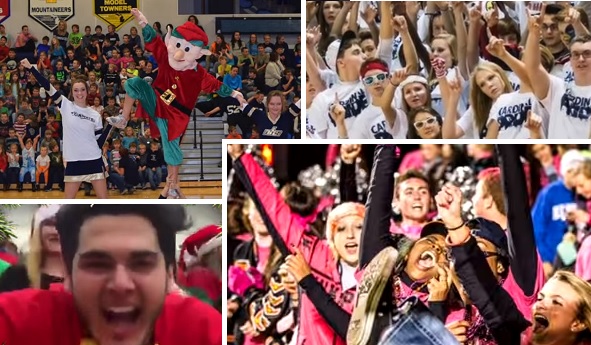
BOTF V: What You Taught Us
February 17, 2016
By Geoff Kimmerly
Second Half editor
We’ve completed our Battle of the Fans statewide tour for 2016, and hopefully you’ve kept up with our visits and learned why our five finalists are candidates to be known as the state’s top high school student section.
 But we appreciate as well the great student sections that entered the contest and weren’t chosen this time for the finalists tour. We try to teach sportsmanship and the best way to support your local teams – but all of our applicants taught us something again this winter.
But we appreciate as well the great student sections that entered the contest and weren’t chosen this time for the finalists tour. We try to teach sportsmanship and the best way to support your local teams – but all of our applicants taught us something again this winter.
Here’s a look at what we learned from the 17 student sections who didn’t make the BOTF Finals, but should be celebrated as well:
Tradition never graduates
Ann Arbor Gabriel Richard’s video took us through five years of its student section. The Fighting Irish were a BOTF finalist in 2013, and the section brings a strong effort every year although a new class of students joins each fall and a veteran group of leaders graduate each spring. Longevity and doing it right earns a lot of respect – not only from us, but surely in the community as well as the section has become such a prominent and positive part of student life at the school.
Get inspired
The Saginaw Michigan Lutheran Seminary student section was represented in a local contest last year by a photo of a few students sitting in the bleachers. Things had to change. Driven by the student council and a league Sportsmanship Summit, the Superfans were born – in fact, superfan became a verb to mean taking part. They’re off to a great start.
Wyoming Godwin Heights’ “Fred’s Fanatic Fans” also got their start this year as part of the Promote Enthusiastic Price (P.E.P.) Club, which was created to cheer on the school’s teams and “build the right climate.” We couldn’t have described the right goal better ourselves.
St. Johns was a finalist in 2015 even as leaders were still working to sway the entire student body toward a new, positive way of thinking and cheering. That movement continued to pay off this year; the Redwings were back, bigger and better, and we were glad to see it.
Be proud
Big Rapids has a few more than 600 students, but we could count at least 150 making up a rowdy crowd at a number of events used in the application video. Everything we could see pointed toward what has to be a blast in the stands.
 Fulton literally spelled out its drive on the screen: “Small Town, Small Teams, Big Hearts, Big Dreams.” The school has 200 students – and like finalist Munising, showed it can be done, filling the stands for a variety of games used in the video.
Fulton literally spelled out its drive on the screen: “Small Town, Small Teams, Big Hearts, Big Dreams.” The school has 200 students – and like finalist Munising, showed it can be done, filling the stands for a variety of games used in the video.
Manton’s Ranger Rowdies may number no more than 280 students, but they certainly bring the noise, literally, which was immediately obvious. Most of the student body had to be in attendance for the games they filmed.
Follow the leaders
Similar to finalist Traverse City West, Detroit U-D Jesuit’s section is driven by its student government. A student senate committee is dedicated to making the section (and whoever came up with the wrecking ball deserves a few more votes in the next election).
We know about the strength of Dowagiac’s leadership firsthand after awarding the section the BOTF 2015 championship. They had a lot of leaders showing the way last year, and that appeared to be true again – a favorite part was a line of students arm-in-arm in the front row, facing the rest of the section during a back-and-forth cheer. And the The Attack's chant shown below always will be a favorite.
Be creative
Tawas’ Brave Cave is full of ideas, starting with in-game interviews of students during an application “broadcast” by TSPN (Tawas Sports Programming Network). Tawas Proud, indeed, and for good reason.
Even if the “D” was upside-down at first on the line of placards spelling out the school’s name in the back row (which was funny), Wayland brought plenty to join the discussion of possible finalists. The “Den” was filled with costumes, signs, and just a lot of material that surely makes for a fun night.
For starters, Pontiac Notre Dame’s name – Irish Thunder – just sounds powerful. It was hard to tell what was going on as part of the “Whistle Cheer,” but it looked pretty wild, especially in front of what appeared to be a giant pep rally crowd (See below).
Involve everyone
Walled Lake Western’s video included interviews with parents and basketball players as well, and one of the athletes said something that especially stuck out: “They cheer the other team and us on.” That’s taking inclusion to another level, and we applaud it.
Utica Ford’s leaders spoke during its application about how the student section was like something bigger than the school itself – something they all have together. And that’s a great thing. (The student section flag was a cool touch as well.)
Holland’s Dutch Nation leaders take getting everyone involved to the highest level, incorporating the pep band and cheerleaders during games and the athletic director and many others at the school behind the scenes. As one said, “We work to spread participation not only for the students, but the whole community.”
Imlay City’s Spartan Nation made shirts like many student sections, but didn’t reserve them for high school students alone – they made them for elementary and middle schoolers and sold to the greater community as well in an effort to get everyone together. (And bringing in Santa Claus for a Christmas-themed game for the younger kids was a neat idea too.)
Ending on one last strong note, we hope Norway is just beginning its BOTF quest. #UKNIGHTED might be the best campaign of BOTF V. They’re “all knights and all united,” and set a great example of getting a community together.
Click to watch all 22 application videos for this year's Battle of the Fans V.

Online Course Trains Leaders Nationwide
By
Geoff Kimmerly
MHSAA.com senior editor
August 11, 2015
By Geoff Kimmerly
Second Half editor
The valuable lessons student leaders have received over the last decade during Captains Clinics presented statewide by Michigan High School Athletic Association staff are now available to students nationwide and beyond as part of an online Captains Course produced by the MHSAA and available from the National Federation of State High School Associations on its Learning Center website.
The Captains Course, created over two years with assistance from Michigan State University’s Institute for the Study of Youth Sports (ISYS), is broken into 10 segments providing instruction on leadership styles and skills to how to handle situations faced by leaders of teams in any sport. A total of 20 past members of the MHSAA Student Advisory Council speak during the program, providing peer-to-peer guidance that has proven effective in student leadership campaigns.
The online Captains Course has been started 2,881 times since its release in July, including 802 times during the first 10 days of this month. The first MHSAA Captains Clinic was conducted in March 2005, and clinics are presented in person on a league-by-league basis to approximately 1,000 students each school year.
The online Captains Course is free and can be downloaded after an account is created on the NFHS Learning Center website at http://www.nfhslearn.com.
“Many student-athletes have characteristics that allow them to become leaders, but rarely do they receive lessons in how to be an effective team captain; this has been the goal of our Captains Clinics and is the aim of this Captains Course,” said MHSAA assistant director Andy Frushour, who coordinates the association’s student services programs and advises the Student Advisory Council. “Our in-person Captains Clinics are still a great way to deliver leadership lessons and to get students from rival schools to interact with each other in a fun and worthwhile way. But we can only do so many in-person clinics per year.
“With the online version, we can deliver the same message, albeit through a different format. And we can do it 24 hours a day, at the user’s convenience, using a medium that kids use like the rest of us use oxygen, and potentially delivering our captains message to exponentially more students than the in-person version; even to students outside of Michigan.”
The online Captains Course is an introductory program, with plans for two more advanced leadership courses that will be facilitated online but with activities and discussions to take place offline in local communities. The goal for the “hands-on” portion of later training courses will be for leaders to conduct interviews with coaches and administrators, write short answers and interact with teammates for a more transformational learning experience.
The first course is made up of 10, 10-minute segments, and takes about two hours to complete – but is meant to be completed over multiple days. The short “bite-sized” segments make it easier for students to digest all of the information being given to them, and are based on research by the Institute for the Study of Youth Sports. Doctoral students working with the institute serve as instructors during Captains Clinics.
The Captains Course is hosted by recent high school graduates Caycee Turczyn of Lapeer High School and Connor Thomas of Marlette. Both were two-year members of the Student Advisory Council; Turczyn will begin studies this fall at the University of Michigan, while Thomas will start at Oakland University.
“All of the lessons are based on research conducted by MSU’s Institute for the Study of Youth Sports,” Frushour said. “Dr. Dan Gould and his doctoral students are rock stars in the field of youth and leadership development, and we are lucky to have them as partners on this project “
The Institute for the Study of Youth Sports was launched in 1978 to establish a world-class institute that would scientifically study the beneficial and detrimental effects of sports participation on children and youth and then work to maximize the beneficial effects. The mission of the Institute for the Study of Youth Sports is to provide leadership, scholarship and outreach that transforms the face of youth sports in ways that maximize the beneficial physical, psychological, and social effects of participation for children and youth while minimizing detrimental effects.
The Student Advisory Council is a 16-member group which provides feedback on issues impacting educational athletics from a student’s perspective, and also is involved in the operation of MHSAA championship events and other programming. Members of the Student Advisory Council serve for two years, beginning as juniors. Eight new members are selected annually to serve on the SAC, with nominations made by MHSAA member schools.
The MHSAA is a private, not-for-profit corporation of voluntary membership by more than 1,400 public and private senior high schools and junior high/middle schools which exists to develop common rules for athletic eligibility and competition. No government funds or tax dollars support the MHSAA, which was the first such association nationally to not accept membership dues or tournament entry fees from schools. Member schools which enforce these rules are permitted to participate in MHSAA tournaments, which attract more than 1.4 million spectators each year.
PHOTO: Lapeer's Caycee Turczyn and Marlette's Connor Thomas host the online Captains Course, with this segment shot at DeWitt High School.

